The $60 CPU Question: AMD Athlon 200GE or Intel Pentium Gold G5400? A Review
by Ian Cutress on January 14, 2019 8:00 AM ESTCPU Performance: System Tests
Our System Test section focuses significantly on real-world testing, user experience, with a slight nod to throughput. In this section we cover application loading time, image processing, simple scientific physics, emulation, neural simulation, optimized compute, and 3D model development, with a combination of readily available and custom software. For some of these tests, the bigger suites such as PCMark do cover them (we publish those values in our office section), although multiple perspectives is always beneficial. In all our tests we will explain in-depth what is being tested, and how we are testing.
All of our benchmark results can also be found in our benchmark engine, Bench.
Application Load: GIMP 2.10.4
One of the most important aspects about user experience and workflow is how fast does a system respond. A good test of this is to see how long it takes for an application to load. Most applications these days, when on an SSD, load fairly instantly, however some office tools require asset pre-loading before being available. Most operating systems employ caching as well, so when certain software is loaded repeatedly (web browser, office tools), then can be initialized much quicker.
In our last suite, we tested how long it took to load a large PDF in Adobe Acrobat. Unfortunately this test was a nightmare to program for, and didn’t transfer over to Win10 RS3 easily. In the meantime we discovered an application that can automate this test, and we put it up against GIMP, a popular free open-source online photo editing tool, and the major alternative to Adobe Photoshop. We set it to load a large 50MB design template, and perform the load 10 times with 10 seconds in-between each. Due to caching, the first 3-5 results are often slower than the rest, and time to cache can be inconsistent, we take the average of the last five results to show CPU processing on cached loading.

As a single threaded test, application loading is a key part of the user experience. Unfortunately the AMD 200GE is 21% slower in this case.
FCAT: Image Processing
The FCAT software was developed to help detect microstuttering, dropped frames, and run frames in graphics benchmarks when two accelerators were paired together to render a scene. Due to game engines and graphics drivers, not all GPU combinations performed ideally, which led to this software fixing colors to each rendered frame and dynamic raw recording of the data using a video capture device.
The FCAT software takes that recorded video, which in our case is 90 seconds of a 1440p run of Rise of the Tomb Raider, and processes that color data into frame time data so the system can plot an ‘observed’ frame rate, and correlate that to the power consumption of the accelerators. This test, by virtue of how quickly it was put together, is single threaded. We run the process and report the time to completion.

In a similar light, the single threaded nature of this test shines on an AMD processor that is 18.6% slower than the Intel competition.
3D Particle Movement v2.1: Brownian Motion
Our 3DPM test is a custom built benchmark designed to simulate six different particle movement algorithms of points in a 3D space. The algorithms were developed as part of my PhD., and while ultimately perform best on a GPU, provide a good idea on how instruction streams are interpreted by different microarchitectures.
A key part of the algorithms is the random number generation – we use relatively fast generation which ends up implementing dependency chains in the code. The upgrade over the naïve first version of this code solved for false sharing in the caches, a major bottleneck. We are also looking at AVX2 and AVX512 versions of this benchmark for future reviews.
For this test, we run a stock particle set over the six algorithms for 20 seconds apiece, with 10 second pauses, and report the total rate of particle movement, in millions of operations (movements) per second. We have a non-AVX version and an AVX version, with the latter implementing AVX512 and AVX2 where possible.
3DPM v2.1 can be downloaded from our server: 3DPMv2.1.rar (13.0 MB)
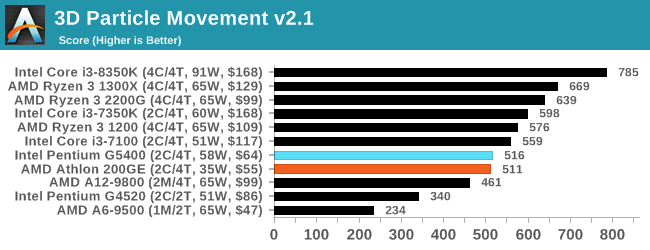
For pure unoptimized throughput, both processors are similar in the 3DPM test.
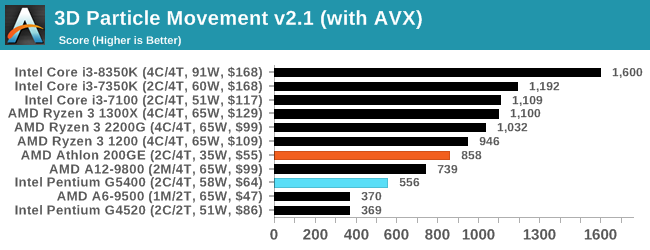
But if we crank on the tuned AVX code, the AMD 200GE scores a big win. On the Pentium, the different code path had almost zero effect, with less than a 10% increase in performance, but the 200GE went up by a good 60% by comparison.
Dolphin 5.0: Console Emulation
One of the popular requested tests in our suite is to do with console emulation. Being able to pick up a game from an older system and run it as expected depends on the overhead of the emulator: it takes a significantly more powerful x86 system to be able to accurately emulate an older non-x86 console, especially if code for that console was made to abuse certain physical bugs in the hardware.
For our test, we use the popular Dolphin emulation software, and run a compute project through it to determine how close to a standard console system our processors can emulate. In this test, a Nintendo Wii would take around 1050 seconds.
The latest version of Dolphin can be downloaded from https://dolphin-emu.org/
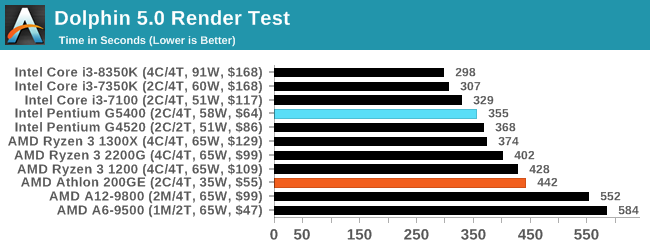
Our emulation test has always been a strong performer for Intel CPUs.
DigiCortex 1.20: Sea Slug Brain Simulation
This benchmark was originally designed for simulation and visualization of neuron and synapse activity, as is commonly found in the brain. The software comes with a variety of benchmark modes, and we take the small benchmark which runs a 32k neuron / 1.8B synapse simulation, equivalent to a Sea Slug.
We report the results as the ability to simulate the data as a fraction of real-time, so anything above a ‘one’ is suitable for real-time work. Out of the two modes, a ‘non-firing’ mode which is DRAM heavy and a ‘firing’ mode which has CPU work, we choose the latter. Despite this, the benchmark is still affected by DRAM speed a fair amount.
DigiCortex can be downloaded from http://www.digicortex.net/
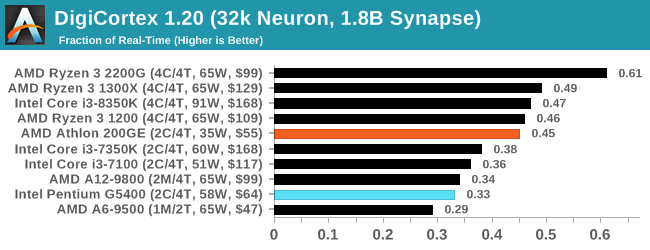
On this more memory limited test, the official supported frequency of the 200GE comes into play, and it scores 37% more than the Intel chip.
y-Cruncher v0.7.6: Microarchitecture Optimized Compute
I’ve known about y-Cruncher for a while, as a tool to help compute various mathematical constants, but it wasn’t until I began talking with its developer, Alex Yee, a researcher from NWU and now software optimization developer, that I realized that he has optimized the software like crazy to get the best performance. Naturally, any simulation that can take 20+ days can benefit from a 1% performance increase! Alex started y-cruncher as a high-school project, but it is now at a state where Alex is keeping it up to date to take advantage of the latest instruction sets before they are even made available in hardware.
For our test we run y-cruncher v0.7.6 through all the different optimized variants of the binary, single threaded and multi-threaded, including the AVX-512 optimized binaries. The test is to calculate 250m digits of Pi, and we use the single threaded and multi-threaded versions of this test.
Users can download y-cruncher from Alex’s website: http://www.numberworld.org/y-cruncher/
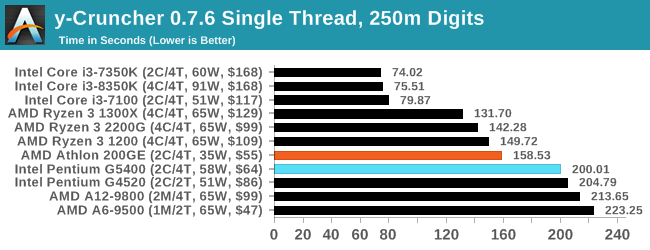
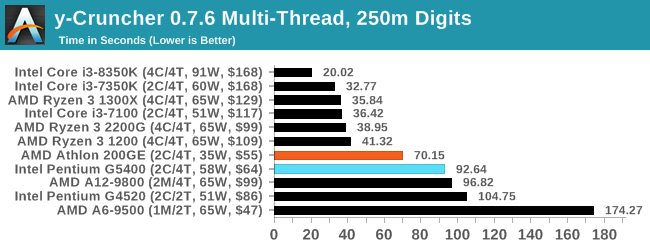
For our second AVX optimized test, AMD again scores a win. It would appear that the Pentium chips from Intel do not seem to be implementing the performance uplifts we see with the Core models.
Agisoft Photoscan 1.3.3: 2D Image to 3D Model Conversion
One of the ISVs that we have worked with for a number of years is Agisoft, who develop software called PhotoScan that transforms a number of 2D images into a 3D model. This is an important tool in model development and archiving, and relies on a number of single threaded and multi-threaded algorithms to go from one side of the computation to the other.
In our test, we take v1.3.3 of the software with a good sized data set of 84 x 18 megapixel photos and push it through a reasonably fast variant of the algorithms, but is still more stringent than our 2017 test. We report the total time to complete the process.
Agisoft’s Photoscan website can be found here: http://www.agisoft.com/
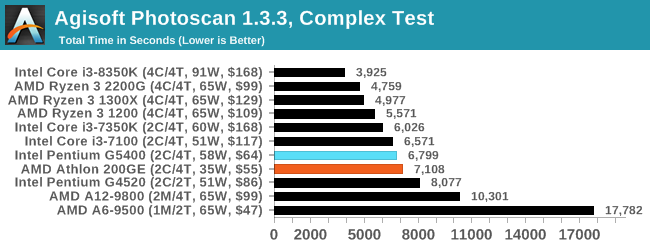
Photoscan is more of a mixed workload, with multithreaded and singlethreaded steps to get a good sense of a performance. The Intel processor slips a win here, a few percent faster than the AMD.


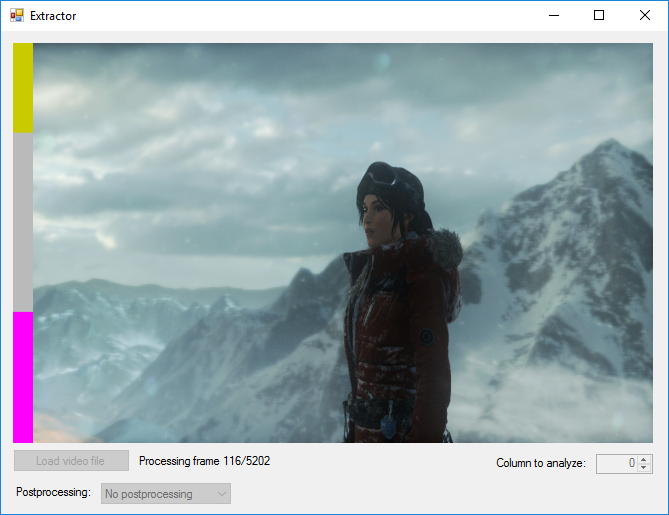










95 Comments
View All Comments
Ryan Smith - Tuesday, January 15, 2019 - link
To be sure, the normal price on the G5400 is ~$64. Past that, we have no specific control over whatever pricing shenanigans Amazon and its partners are up to at any given moment.Irata - Tuesday, January 15, 2019 - link
Define "normal". Yes, the MSRP (manufacturer's suggested retail price) is $64, but you cannot - and have not been able to for a while - find the G5400 anywhere near this price (for stores that actually have them in stock).In terms of pricing - it's not just Amazon or Newegg - many posters here checked sites in various countries and it is more expensive everywhere.
So imho, "normal" pricing would be the actual street price. And if you look at current prices, the Athlon GE's counterpart is actually a lower clocked 2C2T Celeron G4920 with half the G5400's L3 cache or alternatively, the G5400's counterpart would be the Ryzen 2200G / Ryzen 3
As Ian stated that he bought this in Retail - where and when ?
It would have good to either base the review on actually available parts / street prices or add a caveat stating that the G5400 is not available for the msrp.
yannigr2 - Tuesday, January 15, 2019 - link
Bravo, you said everything.People will read this review, go to ANY shop, see the processor at double price and buy a Celeron. because the review told them that the Intel processor is faster in most tasks. This is how consumers behave, especially when they don't have technical knowledge. That's how an RTX 2080Ti sells a GTX 1050 when the RX 570 is faster in every way.
This article is posted for a specific reason, and that's not a fair comparison.
JMO
shabby - Tuesday, January 15, 2019 - link
That's your excuse? We're not first graders here, when an article is based on the price you better make sure no shenanigans affect the price, try harder next time.drzzz - Tuesday, January 15, 2019 - link
What a crappy response Ryan. Given the entire mess about pricing that was made over the i7-7700K a few years ago by this very site. Arguing that street price is the valid metric vice MSRP at the time. Given the article was released without even one editor's note about the G5400 not being available anywhere for the MSRP was just a mistake. Own up to it and correct the article. When I can get a 2400G for the same price as the G5400 there is no comparison in performance or value. Looking at how much of the comments are about the price issues vice any other point from the article and face palm is all I can think about.yannigr2 - Tuesday, January 15, 2019 - link
Really? Is Amazon dictation the G5400 price on the planet? I thought Intel was doing it. Because there is no chance to find this processor at that price on the planet. At least not as new.It WAS nice reading Anandtech this last 15 years.
SaturnusDK - Tuesday, January 15, 2019 - link
No Ryan. The "normal" price is not $64. It's the 1k unit price. You'll probably never see this retail at less than $69... at best.The_Assimilator - Tuesday, January 15, 2019 - link
FFS, all you dipshits complaining "bu... bu... but... G5400 isn't $60" should actually look at the MSRP on Intel's site: https://ark.intel.com/products/129951/Intel-Pentiu...I agree that the chip isn't selling at anywhere near that due to shortages, but Ian has to take a baseline from somewhere and MSRP makes the most sense.
Irata - Tuesday, January 15, 2019 - link
Point taken about the baseline but what's the point of the review if you cannot get the CPU for the MSRP ? The one that's closest price wise is actually a Celeron G 4920.The alternative would have been to either mention that current prices are a lot higher or post the article once the G5400 is again available for MSRP.
Haawser - Tuesday, January 15, 2019 - link
When RX series GPUs were being pushed into stratospheric pricing by mining did reviews quote their 'normal' price, or the price people could actually buy them at ? So why are the rules suddenly different when the situation is reversed and it's the AMD product that's the cheaper option ?